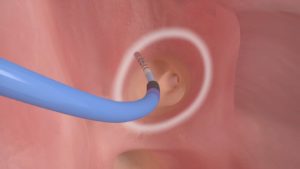
Results from a multicentre study of catheter ablation guided by DEEP (decrement-evoke potential) mapping show that using DEEP mapping meant that ablation was successful in the majority of patients and they could no longer be induced into clinical ventricular tachycardia (VT). The results, published in JACC: Clinical Electrophysiology, showed that out of the 20 patients, 15 (75%) were free of any VT after DEEP guided radiofrequency ablation at six months follow-up and there was a strong reduction in VT burden compared to six months pre-ablation.
Patients were enlisted at four institutions (Toronto General Hospital, Ontario, Canada; John Hunter Hospital and Lake Macquarie Private Hospital, Newcastle, Australia; and Århus University Hospital, Skejby, Denmark) and all had ischaemic cardiomyopathy (ICM) and recurrent episodes of VT despite having received medical therapy.
Substrate maps were created in sinus rhythm or during right ventricular (RV) pacing and access to the left ventricular endocardial surface was achieved with a retroaortic (n=13) or transseptal approach (n=7).
In 16 patients, multi-electrode catheters were used for substrate mapping (Decanav in 9 patients, Pentarray in 6 patients [Biosense Webster, Diamond Bar, California], and Orion in 1 patient [Boston Scientific, Marlborough, Massachusetts]). The rest of patients (n=4) underwent mapping with a 3.5mm irrigated tip ablation catheter (Thermocool SF catheter, Biosense Webster). Late potentials (LP) (potentials with complex high frequency or multicomponent after or at the QRS offset either present in sinus rhythm or seen during RV pacing) were identified and annotated either as location tags or as local activation time (LAT) maps by manually annotating onset of the delayed bipolar EGM.
Patients were predominantly male (95%), and their mean age was 64.6±17.1 years. Mean left ventricular ejection fraction was 33.4±11.4%. The average ablation time was 30.6±20.4 min. Specificity of DEEPs to detect the isthmus of VT was better than that of LPs (0.97 [95% confidence interval [CI]: 0.95 to 0.98] vs. 0.82 [95% CI: 0.73 to 0.89]), without significant differences in terms of sensitivity (0.61 [95% CI: 0.52 to 0.69] vs. 0.60 [95% CI: 0.44 to 0.74], respectively).
The group found that identification of critical myocardial regions for VT maintenance with a reduction of conduction properties (DEEP mapping) by extra stimulus was feasible using contemporary 3D mapping systems. They also found that targeting the DEEP regions (a physiological assessment of the substrate), meant that VT was noninducible in the majority of cases and that areas of DEEPs are localised more frequently in the diastolic pathway of the VT than LPs. They also found that the mid-term outcomes of this limited focused mechanistic ablation strategy using extra stimulus were in keeping with the current ablation outcomes.
Initial results of catheter ablation guided solely by the DEEP technique are encouraging, with the majority of patients rendered noninducible for clinical VT. Automation of the DEEP technique will allow for rapid identification of DEEP potentials enabling further validation of such a strategy in a randomised study.












